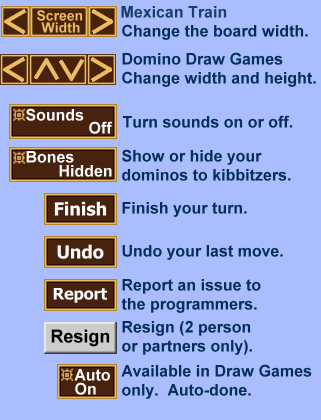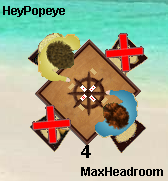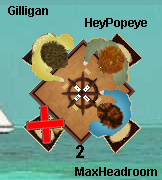Game Features


Common in all versions of Domino
For all versions of Domino:
- "Bone", "Tile" or Domino all mean the same thing - the playing piece
- To make a move, click on one of your Bones to highlight it, and then click where you want to play it.
- Deal 5, 6 or 7 bones at the start.
The one exception is that in Mexican Train 4 Player, you can only choose 5 or 6 bones at the start, because there are not enough bones for 4 Player Train. - Number of players including 2, 3, 4 (cutthroat or partners).
Special seatings for 2 and 3 Player games. To avoid confusion when looking at the scoring:
- You can only use Seats 1 and 3 for 2 Player games
- You can only use Seats 1, 2 and 3 can be used for 3 Player games.
- If either Seat 2 or 4 is occupied, you will not get an option to start a 2 Player game
- If Seat 4 is occupied, you will not get an option to start a 3 Player game.


About Spinners
- Spinners are doubles that can be played on all four sides.
- Doubles that are not Spinners can only be played on the opposite long sides.
- In Multi-Spinners and Fives Up, all doubles are treated as Spinners.
- In Mexican Train and Muggins, doubles are never Spinners.
- In All Fives, only the first double played is a Spinner
Mexican Train Dominoes Game Rules
Objective of the Game
Winner is the lowest score, either individually, or the combined score of the partners.
- The game consists of 7 rounds.
- Each player gets five tiles by default at the beginning of each round.
- Remaining tiles with the exception of the lead double, are set aside forming a boneyard.
- Each round starts with a lead double. In a game played with double-six dominoes set, first round starts with [6-6]. Subsequent rounds start with next lower double([5-5], [4-4], and so on).
Order of Play
- Mexican Train Dominoes is played in multiple rounds with aim to score lowest at the end of all rounds to win.
- At the beginning of each round, a bone is drawn for each player where the player with the highest value goes first.
- The lead double is taken out and placed at the top. Each player then receives their bones.
- Each player has a personal train on which they can play. The Mexican train is also available for all players to play AFTER the first turn of each round.
First Turn
- Players can only play on their own train. A player can play as many tiles as possible starting with the tile matching the lead double for that round.
- If a player's last bone is a double, they do not need to satisfy it.
- If a play cannot play any bone, their train is marked open, and the move goes to the next player. They do not draw an extra tile.
- If a player plays all their bones in their first turn, all other players get to finish their first turn before the round is over.
After first turn
- In subsequent rounds player can only play one tile if it is non-double. They can play on their own train, the Mexican train, and on any opponent's train that has their "Train" open.
- If a player plays a double, and it is not their last bone, they must either:
- Play an additional tile if they have one to play.
- If they don't have an additional tile, they automatically draw one from the boneyard. If they can now close the open double, they must do so before their turn ends.
- At the beginning of a turn (after the first one), if there is an open double, then the player's only move is to close the open double.
If they cannot close an open double, then they automatically draw from the boneyard. If they can now close the open double, they must do so before their turn ends. - If a player can not make a move after their first turn, he/she draws one tile from the boneyard. If the tile can be played, then it must be played. If the tile cannot be played, their train is marked open and then the turn is passed to the next player.
- A player's personal train that is marked open can only be unmarked if the player plays a bone on their own train. After it is unmarked, it becomes unavailable for play by other players.
End of Round/Game
- A round ends under one of two conditions:
Either one player plays all their tiles (see "First Turn" for one exception),
or the boneyard is empty and all players cannot make another make a play. - Once a round ends, the remaining bones in their hand are totaled and added to their score.
- After the end of last round (for lead [0-0]), the player with the lowest score wins.
Draw Dominoes (Multiple Spinners) Game Rules
Objective of the game
Winner is the highest score, either individually, or the combined score of the partners.
- There are no set number of rounds
- Each player gets five tiles by default at the beginning of each round.
- Remaining tiles are set aside forming a boneyard.
Order of Play
- First turn or lead is decided by a draw of lot and in subsequent rounds player sitting next to previous leader gets the first turn.
- Turn can be started with any tile and then subsequent tiles can be played at the two ends of the train.
- All doubles are played as spinners in the game and can be played at all four ends.
- If a player can not play, then he/she must draw from the boneyard until either he/she gets a playable tile or the boneyard has only two tiles left. Last two tiles from the boneyard can not be drawn.
- If player draws a tile which can be immediately played, then it must be played.
- If player can not play a tile and can not draw from the boneyard either, he/she simply passes the turn to next player.
End of Round/Game
- The round ends if a player has played all of his/her tiles. Round can also end if the game is blocked which means no tile can be played by any player.
- Winner of the round is the player who played all his/her tiles, or the player with lowest score.
- Player scores the total of all other players' tiles pip count minus pip count of his/her own tiles (if game was blocked). If two players get similar score then there is no winner for the round and no player is awarded any point.
- Though players score during the game play, game can only end after the end of a round. It is possible that the first player to reach the score of 100 is not the winner if the round is won by another player who after adding the bonus points has the highest overall score.
Partners
Partners' scores are added together at the end of a hand to determine if they have met or passed the final score. As in singles, each player has their own scores and
the highest score wins, not the first to meet the final score.
Score Options
Choice of final score of 50,100, 150, 200, 250, 300.
All Fives Dominoes Game Rules
Objective of the game
Winner is the highest score, either individually, or the combined score of the partners.
- In All Fives Dominoes game, players try to match all scoring ends of the layout on their turn so that its total is a multiple of five which is scored immediately by the player. In addition winner of each round scores bonus points at the end of each round.
- Each player gets five tiles by default at the beginning of each round.
- Remaining tiles are set aside forming a boneyard.
Order of Play
- First turn or lead is decided by a draw of lot (each player draws one tile and highest tile starts the round). In subsequent rounds player winning the previous round starts first. If there was no winner for the previous round then lead is again decided by draw of lot.
- Turn can be started with any tile and then subsequent tiles can be played at the open ends of the layout.
- In All Fives only the first double is a spinner which means tiles can be placed on all four edges of the spinner double.
Other doubles can only be played on the sides, not the ends. - If a player can not play, then he/she must draw from the boneyard until either he/she gets a playable tile or the boneyard has no tile left.
- If player draws a tile which can be immediately played, then it must be played.
- If player can not play a tile and can not draw from the boneyard either, then he/she simply passes the turn to next player.
End of Turn/Round/Game
- The round ends if a player has played all of his/her tiles. Round can also end if the game is blocked which means no tile can be played by any of the players.
- After a player plays a tile, all open ends of the layout are totaled and if the total is a multiple of five (5, 10 etc.), then player immediately scores that total.
- Doubles at the end of an arm in the layout are worth its pips count. Once two tiles are placed on a double, its pip count is not considered in the total (even when the spinner has one or two edges available to place tiles).
- The open ends of the arms on all four edges of the spinner double are counted in the score.
- First player playing all his/her tiles wins the round. If the game is blocked then player with the lowest pips count in his/her hand wins.
- After the round ends, pips on all remaining tiles of all players are counted and rounded up or down to nearest multiple of five and then divided by five which is scored by the winner of that round.
- The game is played for multiple rounds and player with highest score above 100 wins.
- Though players score during the game play, game can only end after the end of a round. It is possible that the first player to reach the score of 100 is not the winner if the round is won by another player who after adding the bonus points has the highest overall score.
Partners
Partners' scores are added together at the end of a hand to determine if they have met or passed the final score. As in singles, each player has their own scores and
the highest score wins, not the first to meet the final score.
Score Options
Choice of final score of 50,100, 150, 200, 250, 300.
Five Up Dominoes Game Rules
Objective of the game
Winner is the highest score, either individually, or the combined score of the partners.
- In Five Up all doubles are spinners which means tiles can be placed on all four edges of the double.
- If a player can not play, then he/she must draw from the boneyard until either he/she gets a playable tile or the boneyard has no tile left.
- If player draws a tile which can be immediately played, then it must be played.
- If player can not play a tile and can not draw from the boneyard either, then he/she simply passes the turn to next player.
Order of Play
- First turn or lead is decided by a draw of lot (each player draws one tile and highest tile starts the round). In subsequent rounds player winning the previous round starts first. If there was no winner for the previous round then lead is again decided by draw of lot.
- Turn can be started with any tile and then subsequent tiles can be played at the open ends of the layout.
- After a player plays a tile, all open ends of the layout are totaled and if the total is a multiple of five (5, 10 etc.), then player immediately scores that total divided by five.
- Doubles at the end of an arm in the layout are worth its pips count. Once two tiles are placed on a double, its pip count is not considered in the total (even though it may have one or two edges available to place tiles).
- The open ends of the arms on all four edges of a double are counted in the score.
- First player playing all his/her tiles wins the round. If the game is blocked then player with the lowest pips count in his/her hand wins.
End of Turn/Round/Game
- The round ends if a player has played all of his/her tiles. Round can also end if the game is blocked which means no tile can be played by any of the players.
- After the round ends, pips on all remaining tiles of all players are counted and rounded up or down to the nearest multiple of five and then divided by five which is scored by the winner of that round.
- The game is played for multiple rounds and player with highest score above 100 wins.
- Though players score during the game play, game can only finish after end of a round. It is possible that the first player to reach the score of 100 is not the winner if the round is won by another player who after adding the bonus points has the highest overall score.
Partners
Partners' scores are added together at the end of a hand to determine if they have met or passed the final score. As in singles, each player has their own scores and
the highest score wins, not the
first to meet the final score.
Score Options
Choice of final score of 50,100, 150, 200, 250, 300.
Muggins Dominoes Game Rules
Objective of the game
Winner is the highest score, either individually, or the combined score of the partners.
- In Muggins Dominoes game, players try to match two ends of the layout on their turn so that its total is a multiple of five which is scored immediately by the player. In addition winner of each round scores bonus points at the end of each round.
- Each player gets certain number of tiles at the beginning of each round.
- Remaining tiles are set aside forming a boneyard.
Order of Play
- First turn or lead is decided by a draw of lot (each player draws one tile and highest tile starts the round). In subsequent rounds player winning the previous round starts first. If there was no winner for the previous round then lead is again decided by draw of lot.
- Turn can be started with any tile and then subsequent tiles can be played at the two ends of the layout.
- There is no spinner in Muggins Dominoes game so a double can only be played at two ends.
- If a player can not play, then he/she must draw from the boneyard until either he/she gets a playable tile or the boneyard has no tile left.
- If player draws a tile which can be immediately played, then it must be played.
- If player can not play a tile and can not draw from the boneyard either, then he/she simply passes the turn to next player.
End of Turn/Round/Game
- The round ends if a player has played all of his/her tiles. Round can also end if the game is blocked which means no tile can be played by any of the players.
- When a player plays a tile, the two open ends of the layout are totaled and if the total is a multiple of five (5, 10 etc.), then player immediately scores that total.
- Doubles at the end of the layout are worth its pips count.
- First player playing all his/her tiles wins the round. If the game is blocked then player with the lowest pips count in his/her hand wins.
- After the round ends, pips on all remaining tiles of all players are counted and rounded up or down to nearest multiple of five and then divided by five which is scored by the winner of that round.
- The game is played for multiple rounds and player with highest score above 100 wins.
- Though players score during the game play, game can only end after end of a round. It is possible that the first player to reach the score of 100 is not the winner if the round is won by another player who after adding the bonus points has the highest overall score.
Partners
Partners' scores are added together at the end of a hand to determine if they have met or passed the final score. As in singles, each player has their own scores and
the highest score wins, not the
first to meet the final score.
Score Options
Choice of final score of 50,100, 150, 200, 250, 300.








